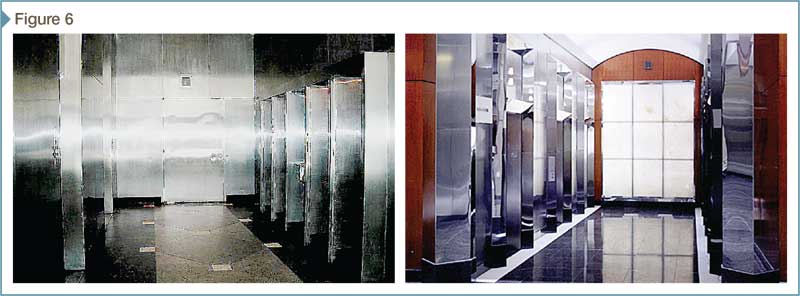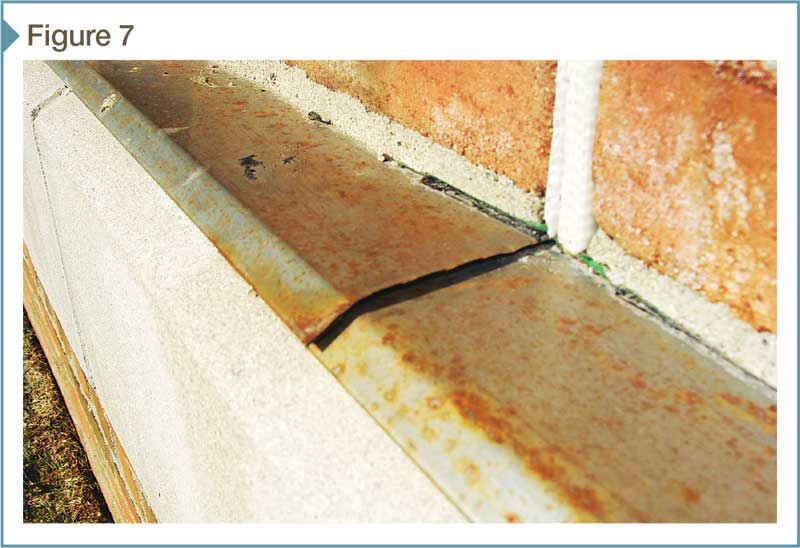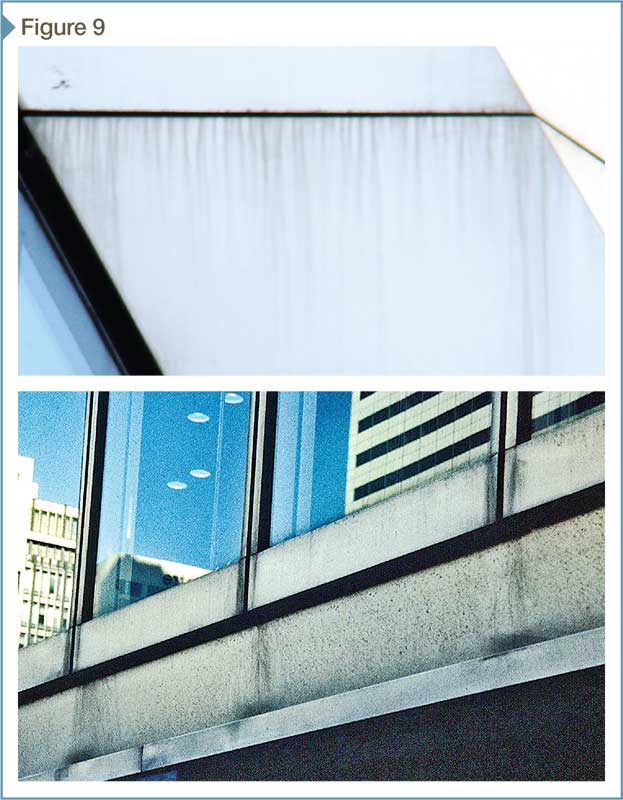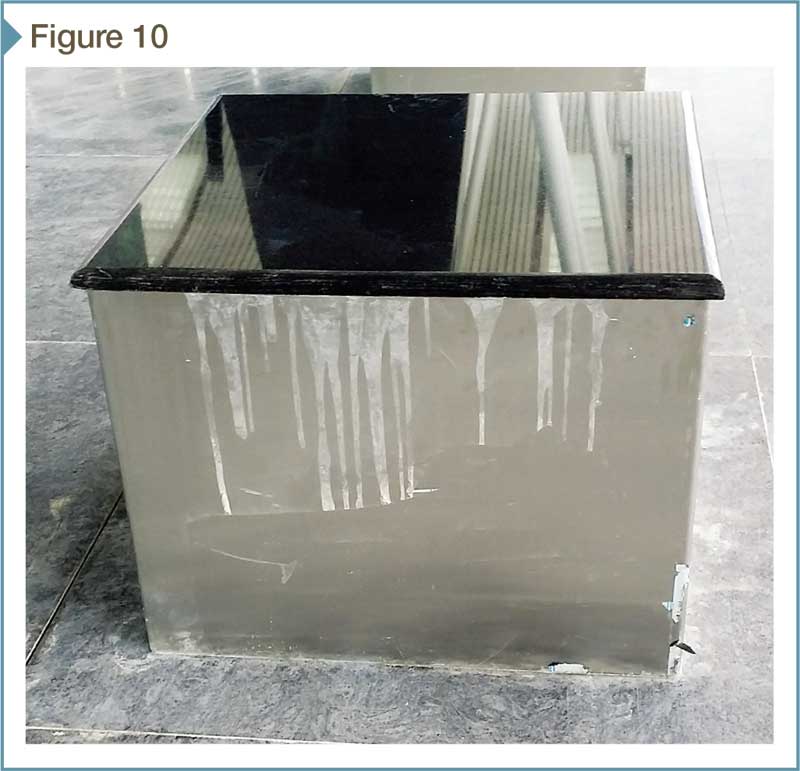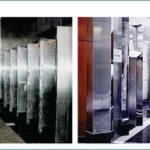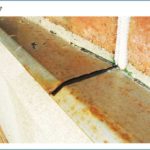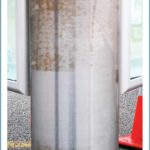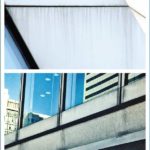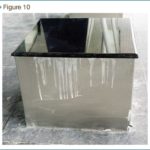Clear coatings, oil, and wax
Stainless steel provides the best corrosion resistance when the surface is clean and exposed to oxygen. Clear coatings prevent oxygen exposure and can potentially cause corrosion problems and increase maintenance costs. The most problematic coatings are those that peel or delaminate; they create crevices as they fail, increasing corrosion problems.
Coatings increase surface reflectivity and can yellow over time. When applied in the field, service life is typically relatively short; repeated removal and replacement can be more expensive than simple cleaning. Further, some require such hazardous chemicals for removal that contractors frequently remove them by abrasion, destroying the initial surface.
If a coating must be applied to hide fingerprints or improve corrosion performance, one should select products that naturally dissipate or are easily removed to avoid finish damage—examples include oil, wax, and silicon mixtures. With the exception of lanolin polishes that dry hard and add natural corrosion protection, oils should not be used in exterior applications, swimming pool environments, or any other location with airborne dust or corrosive substances (e.g. salt or pollution), as they increase surface accumulations and can cause corrosion. Carnauba wax and similar automotive waxes that dry hard are also acceptable, but do not provide a corrosion-inhibitor.
Oil, wax, and silicon coatings can be helpful in indoor locations where fingerprinting is a concern. It is important to select products carefully since some do not harden and accumulate dirt (Figure 6).
Hydrochloric acid
Hydrochloric acid (i.e. muriatic acid) is very corrosive to construction materials; it should never be used for cleaning tile, concrete, or masonry near stainless steel. Concentrations of as little as 0.1 percent can cause room temperature corrosion of Type 304/304L (UNS S30400/S30403).
If there is accidental exposure, the surface should be immediately and thoroughly rinsed with clean water and the acid should be neutralized (Figure 7). Alternative cleaning products are available.
Adherent deposits
Degreasers can be very helpful in loosening some adherent deposits not involving adhesives. If the finish is not mirror-like, colored, or coated, then very fine abrasive powders suitable for cleaning glass can be effective when made into a paste and gently rubbed on the surface. (They should first be tested on a small area to make certain no surface damage occurs.)
The surface must be rinsed thoroughly to remove the white powder residue. A soft cloth or nylon brush can be used to loosen the powder. Calcium carbonate, which is used in toothpaste, is preferred because it does not scratch most finishes and is environmentally neutral. Fine crystalline silica, pumice powders, and baking soda (sodium bicarbonate) are also used. Coarse scouring powders should be avoided as they can contain bleach and can scratch surfaces.
Adhesive removal
Removal of residual adhesive deposits from protective strippable films, posters, and other sources can usually be accomplished without damaging the stainless steel surface. If the supplier can be identified, it should be contacted for removal advice. Several different adhesives are used in construction, and the appropriate removal products vary.
When recently applied, some can be removed with an eraser, mild detergent, vinegar (or ammonia), and water mixture. Plastic bristle brushes and scrapers may assist in removal, but anything that could scratch the surface should be avoided. Non-toxic household adhesive removers are also often very effective. If the finish is not mirror-polished or colored, fine abrasive cleaners suitable for glass can be made into a paste and then gently rubbed on with the grain to assist in removal. A strong solvent may be required, but it should be tested on a small area in advance and washed off completely afterward (Figure 8).
Sealant failure
‘Rundown’ occurs when fluids are released from sealant, producing dark areas or streaks below the joints as dirt, hydrocarbons, and other substances in the air collect on the tacky surface. The causes can range from poor installation to chemical exposure to normal end-of-service-life deterioration. (See the Failures article from the April 1997 issue of The Construction Specifier, “Premature Sealant Failure,” written by David H. Nicastro and Joseph P. Solinski.)
Discoloration color is determined by the type of particulate adhering to the sealant. This aesthetic problem is different in appearance from the normal rain/dirt runoff patterns occurring at window corners or directly under a joint (Figure 9). The appropriate removal product depends on the sealant type.
Paint and marker pens
Paint and marker pen stains can be removed using proprietary alkaline or solvent paint-strippers after testing the product on a stainless steel sample or in a low-visibility area to ensure it does not cause any surface discoloration. A soft, nylon bristle brush can be helpful in loosening residue. Some proprietary chemical cleaners can damage sealant—care should be used to prevent inadvertent damage.
Cement and mortar
If cement or mortar is accidentally spilled onto stainless steel, it should be washed off immediately with adequate water before it can set. Otherwise, removing solidified material can be difficult without causing surface damage. If the surface is smooth, it may fall off as it dries. Low-power-washing can also be tried, with the water stream angled to loosen the deposit edge.
If the cement or mortar has been allowed to dry on the surface, dark multi-color alkaline staining may be apparent on the stainless steel surface after the deposit is removed. This can be removed by rubbing a paste of fine abrasive powders and water on the surface. However, if the stainless steel surface is colored or coated with metal, permanent surface damage may occur (Figure 10).
Conclusion
Appropriate cleaning of stainless steel can frequently restore the original appearance of stainless steel. There is generally no reason to use products damaging to the environment or hazardous to workers. Cleaning frequency is determined by the owner’s expectations, site conditions, and appropriateness of the stainless steel and finish.
Generally, only occasional cleaning is required to remove surface deposits. However, care should be taken in applying coatings since some can adversely affect corrosion performance. With appropriate procedures and products, stainless steel can stand the test of time. (The author would like to acknowledge the support of the Nickel Institute and IMOA in the preparation of this article.)
Catherine Houska, CSI, is a senior development manager at TMR Consulting. She is a metallurgical engineering consultant with an MBA specializing in architectural metal specification, restoration, failure analysis, atmospheric corrosion, finishes, and market development. Houska has authored more than 190 publications (including several features for The Construction Specifier), and received CSI’s 2016 Technical Document Award. She can be reached via e-mail at chouska@tmr-inc.com.



